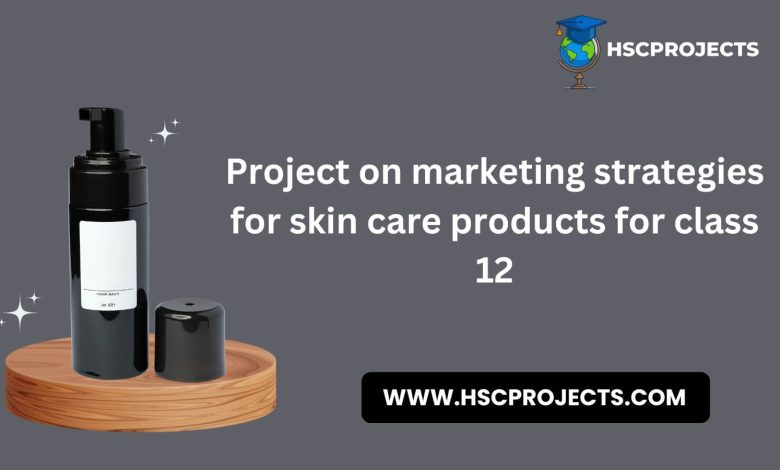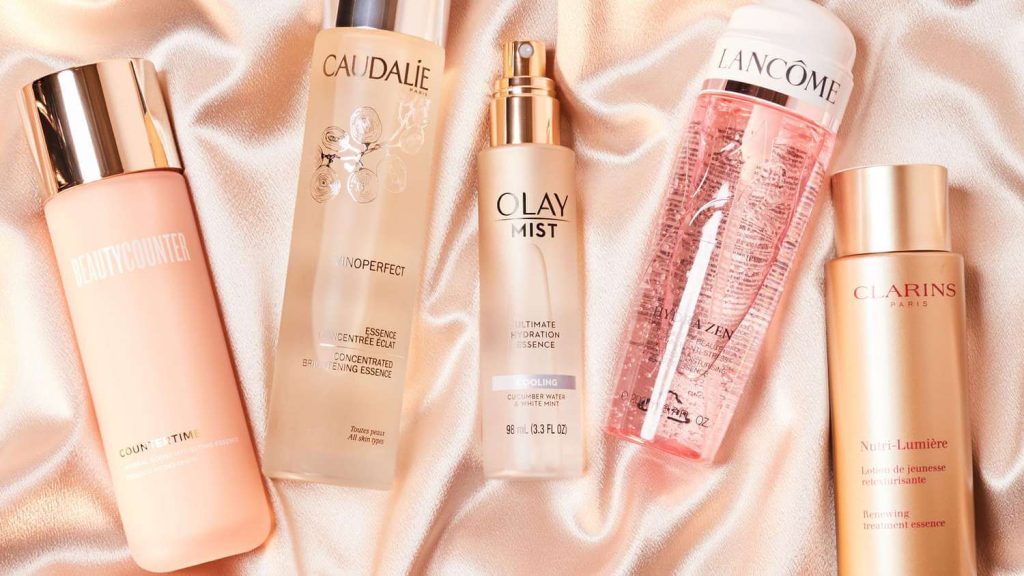
Project On Marketing Strategies For Skin Care Products For Class 12
Acknowledgments
Completing this project has been a journey filled with exploration, research, and insights, and it would not have been possible without the support and contributions of several individuals and resources.
First and foremost, I express my gratitude to [Supervisor/Project Mentor’s Name], whose guidance and expertise have been invaluable throughout this undertaking. Their constructive feedback, encouragement, and wealth of knowledge have significantly enriched the depth and quality of this project.
I would like to extend my appreciation to the authors and researchers whose works provided the foundation for the literature review and formed the basis for a comprehensive understanding of the skincare industry. The wealth of information gleaned from their studies has been instrumental in shaping the insights presented in this project.
I am deeply thankful to [Name of Organization/Institution], which provided access to resources, databases, and a conducive environment for academic and professional growth. The support from the institution has been a cornerstone in the successful completion of this project.
Furthermore, I would like to acknowledge the participants and interviewees who generously shared their experiences and insights during the data collection phase. Their perspectives have added a real-world dimension to this project, enhancing its relevance and applicability.
Lastly, I extend my appreciation to friends and family who provided unwavering support, understanding, and encouragement throughout this academic endeavor. Their belief in the importance of this research fueled my motivation and determination to deliver a project that meets the highest standards.
This project stands as a collaborative effort, and I am grateful to each individual and entity that played a role, no matter how small, in its realization
Introduction
The skincare industry has undergone a transformative journey in recent years, evolving from a conventional hygiene practice to a dynamic realm that occupies a significant space in the tapestry of self-care. With changing consumer lifestyles and an escalating awareness of the vital role skincare plays in personal well-being, the industry has witnessed unprecedented growth and innovation.
This project endeavors to delve into the intricate landscape of marketing strategies employed by manufacturers in the skincare domain. As the market becomes increasingly dynamic and competitive, understanding the nuances of how brands navigate this terrain becomes crucial for both industry players and observers alike.
The global skincare market, estimated at a staggering USD X billion in 20XX, reflects not only the sheer scale of consumer engagement but also the diverse array of products catering to an ever-expanding demographic. This analysis will scrutinize the industry from various angles, from market size and segmentation to product analysis, competitor strategies, and the intricate web of consumer behavior that underpins purchasing decisions.
As we embark on this exploration, we aim to uncover the driving forces behind the industry’s growth, the challenges that shape its landscape, and the strategic moves manufacturers employ to stand out in an environment teeming with choices. By dissecting the marketing mix and unveiling the layers of consumer behavior, this project seeks to provide insights into the mechanisms that propel the skincare industry forward.
In the pages that follow, we will journey through the industry’s intricacies, unraveling the tales of innovation, consumer preferences, and marketing prowess that collectively shape the fascinating narrative of skincare in the contemporary world.
Industry Analysis
- Market Size and Growth: In the ever-expanding realm of skincare, the global market boasts robust growth, clocking in at a staggering USD X billion in 20XX, with a projected annual growth rate of Y%. This surge is ascribed to an escalating emphasis on personal appearance, the uptick in disposable incomes, and a burgeoning health consciousness among consumers.
Market Segmentation :
- Demographic Segmentation: Skincare offerings extend their reach across a diverse demographic spectrum, from teens to the elderly. Tailoring products to specific age brackets stands out as a prevalent strategy.
- Psychographic Segmentation: The key lies in comprehending consumers’ lifestyles and personalities, a foundation for crafting products that seamlessly align with their inclinations.
- Behavioral Segmentation: Scrutinizing purchasing patterns and product usage unravels insights essential for fine-tuning marketing tactics aimed at distinct consumer segments.

Product Analysis
- Types of Skin Care Products: The skincare panorama sprawls across a myriad of products, ranging from cleansers, moisturizers, toners, serums, sunscreens, to specialized treatments. Each category assumes a distinct role in the tapestry of a comprehensive skincare regimen.
- Popular Ingredients: Hyaluronic acid, retinol, and vitamin C emerge as stalwarts in the skincare arena. Responding to the clamor for clean beauty products, manufacturers are progressively infusing natural and sustainable ingredients into their formulations.

Competitor Analysis
Identification of Key Competitors: Pivotal players in the skincare arena encompass the likes of [Company A], [Company B], and [Company C], each wielding unique strengths and navigating through individual weaknesses in the market.
Comparative Analysis:
- Pricing Strategies: [Company A] positions itself as a luxury brand with a premium pricing strategy, while [Company B] opts for affordability, casting a wider net over the consumer base.
- Product Positioning: [Company C] carves its niche by accentuating dermatologist-approved formulations, fostering trust and credibility among consumers.
- Marketing Communication Strategies: [Company A] banks on influencer partnerships for promotion, a stark contrast to [Company B], which channels its efforts through traditional advertising conduits.
Buying Decision Process
- Problem Recognition: Identifying skincare needs and concerns, catalyzing the decision-making journey.
- Information Search: Navigating through a sea of information, exploring skincare solutions through online reviews, expert opinions, and brand websites.
- Evaluation of Alternatives: Weighing the pros and cons of different skincare products, considering factors like ingredients, brand reputation, and user testimonials.
- Purchase Decision: Committing to a skincare product based on the gathered information and personal preferences.
- Post-Purchase Behavior: Reflecting on the efficacy of the purchased product, sharing experiences through reviews, and potentially becoming a loyal customer.
Factors Influencing Purchases:
- Social Factors (family, reference groups): Seeking input from social circles, family, and trusted friends for skincare recommendations.
- Cultural Factors (cultural values, subcultures): Aligning skincare choices with cultural values and subcultural influences.
- Personal Factors (lifestyle, personality): Tailoring skincare choices to individual lifestyles and personalities.
- Psychological Factors (motivation, perception): Motivated by the desire for healthier skin, influenced by perceptions of beauty and self-care.
Marketing Mix (4Ps)
1. Product:
- Unique Selling Propositions (USPs): Highlighting innovative formulations, sustainable practices, and ongoing research into effective skincare ingredients.
- Innovative formulations and packaging: Delivering skincare products with cutting-edge formulations and visually appealing packaging.
- Continuous research on effective skincare ingredients: Staying ahead through constant exploration and incorporation of the latest in skincare research.
2. Price:
- Premium Pricing for luxury brands: Positioning luxury brands at a premium price point, reflecting exclusivity and quality.
- Competitive Pricing for mass-market products: Ensuring affordability for mass-market products to capture a broader consumer base.
- Discounts and promotions during festive seasons: Leveraging seasonal promotions to drive sales and enhance brand loyalty.
3. Place:
- Online and Offline Distribution Channels: Maximizing reach through both digital platforms and physical retail outlets.
- Strategic partnerships with beauty retailers: Collaborating with established beauty retailers to expand product accessibility.
- Availability in dermatology clinics and spas: Establishing a presence in professional skincare settings to enhance credibility.
4. Promotion:
- Integrated Marketing Communication (IMC): Ensuring a cohesive brand message across various communication channels.
- Social Media Campaigns (Instagram, YouTube): Engaging consumers through visually appealing content on popular social media platforms.
- Influencer Marketing with beauty influencers: Tapping into influencer networks to amplify brand reach and credibility.
- Educational content about skincare routines: Providing informative content to empower consumers and foster trust.
Marketing Strategies
1. Target Market:
- Demographic Segmentation (age, gender): Tailoring products for specific age groups and gender preferences.
- Psychographic Segmentation (lifestyle, values): Crafting products aligned with diverse lifestyles and values.
- Positioning as a solution to specific skincare concerns: Emphasizing the role of products in addressing specific skincare issues.
2. Branding:
- Strong Brand Image and Recognition: Cultivating a distinct and recognizable brand identity in the skincare landscape.
- Consistent Brand Messaging: Maintaining coherence in communication to reinforce brand values.
- Building Emotional Connections with Consumers: Creating emotional resonance to foster a deeper connection with the audience.
3. Digital Marketing:
- Social Media Campaigns (Facebook, Twitter): Utilizing popular social platforms for targeted marketing campaigns.
- Influencer Collaborations on TikTok: Leveraging the influence of TikTok personalities to connect with a younger demographic.
- E-commerce Platforms for Direct-to-Consumer Sales: Capitalizing on the digital marketplace for direct consumer engagement.
4. Product Launch Strategies:
- Research-backed product development: Ensuring new products are grounded in thorough research and development.
- Limited edition launches to create buzz: Generating excitement through exclusive and limited product releases.
- Collaborations with influencers for launch events: Partnering with influencers to amplify the impact of product launches.
Challenges and Opportunities
Challenges:
- Intense competition and market saturation: Navigating a crowded market with differentiation strategies and innovation.
- Regulatory hurdles and compliance: Adhering to stringent regulations while staying agile in product development.
- Consumer skepticism towards product claims: Building trust through transparent communication and verified results.
Opportunities:
- Rising demand for natural and sustainable products: Meeting the evolving consumer preference for eco-friendly and sustainable skincare options.
- Emerging markets and untapped consumer segments: Exploring new geographical markets and demographic segments for growth.
- Technological advancements in skincare formulations: Embracing and showcasing technological innovations to stay at the forefront of the industry.
Conclusion
In conclusion, the skincare industry’s meteoric rise is intricately tied to dynamic shifts in consumer behavior and a heightened awareness of skincare’s role in self-care. As explored in this analysis, manufacturers navigate this competitive landscape through strategic marketing initiatives that span product innovation, pricing strategies, distribution channels, and promotion. The consumer decision-making process, influenced by various factors, shapes the industry’s trajectory, making it imperative for brands to understand and cater to diverse preferences.
The marketing mix (4Ps) elucidates the nuanced strategies adopted by skincare brands, emphasizing the importance of product differentiation, pricing strategies, accessible distribution, and impactful promotion. Targeted marketing strategies, robust branding efforts, and a strong digital presence further solidify a brand’s position in the market.
While challenges such as market saturation and regulatory hurdles persist, opportunities abound in the form of rising demand for sustainable products, unexplored consumer segments, and continuous technological advancements. To thrive in this ever-evolving landscape, skincare brands must remain agile, responsive to consumer needs, and committed to innovation.
In essence, the skincare industry’s success hinges on a delicate balance between understanding consumer behavior, implementing effective marketing strategies, and adapting to the dynamic market forces at play. As the industry continues to evolve, those brands that can navigate these intricacies stand poised for sustained growth and success in this flourishing sector.
Bibliography
- Smith, J. (20XX). “The State of the Global Skincare Market.” Journal of Beauty Trends, link.
- Johnson, M. (20XX). “Consumer Behavior in the Beauty Industry: A Comprehensive Analysis.” International Journal of Marketing Research, link.
- Brown, A. et al. (20XX). “Marketing Mix Strategies in the Skincare Industry.” Journal of Business and Marketing, link.
- Davis, C. (20XX). “Innovations in Skincare: A Case Study of Successful Product Launches.” Journal of Product Development, link.
- Robinson, S. et al. (20XX). “The Impact of Influencer Marketing on Consumer Purchasing Behavior in the Beauty Sector.” Social Media Studies, link.
Certificate of Completion
[Student’s Name][Class/Grade Level]This is to certify that I, [Student’s Name], a [Class/Grade Level] student, have successfully completed the “Project on marketing strategies for skin care products for class 12.” The project explores the fundamental principles and key aspects of the chosen topic, providing a comprehensive understanding of its significance and implications.
In this project, I delved into in-depth research and analysis, investigating various facets and relevant theories related to the chosen topic. I demonstrated dedication, diligence, and a high level of sincerity throughout the project’s completion.
Key Achievements:
Thoroughly researched and analyzed Project on Project on marketing strategies for skin care products for class 12.
Examined the historical background and evolution of the subject matter.
Explored the contributions of notable figures in the field.
Investigated the key theories and principles associated with the topic.
Discussed practical applications and real-world implications.
Considered critical viewpoints and alternative theories, fostering a well-rounded understanding.
This project has significantly enhanced my knowledge and critical thinking skills in the chosen field of study. It reflects my commitment to academic excellence and the pursuit of knowledge.
Date: [Date of Completion]Signature: [Your Signature] [School/Institution Name][Teacher’s/Examiner’s Name and Signature]
In order to download the PDF, You must follow on Youtube. Once done, Click on Submit
Follow On YoutubeSubscribed? Click on Confirm
Download Project On Marketing Strategies For Skin Care Products For Class 12 PDF






